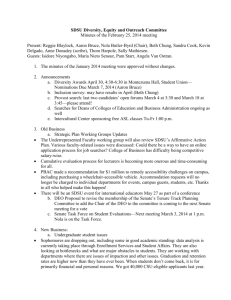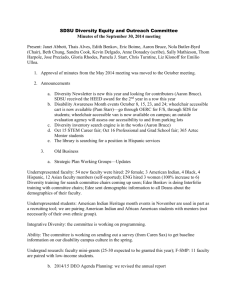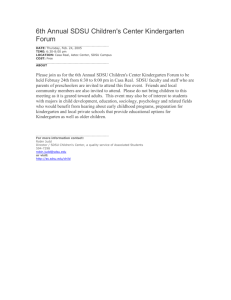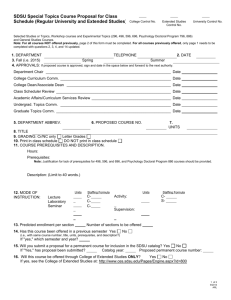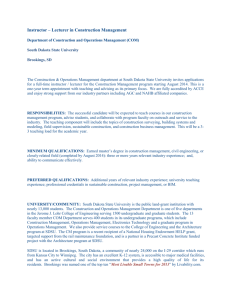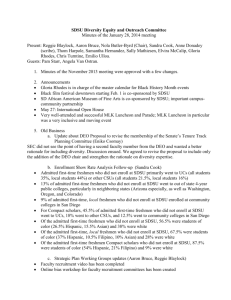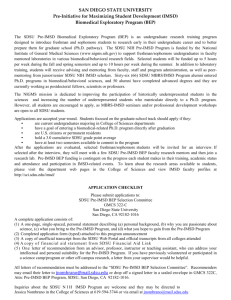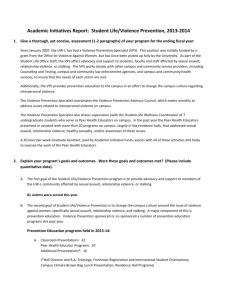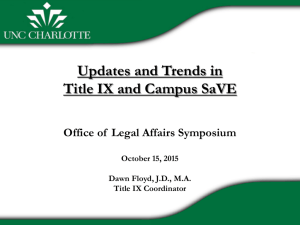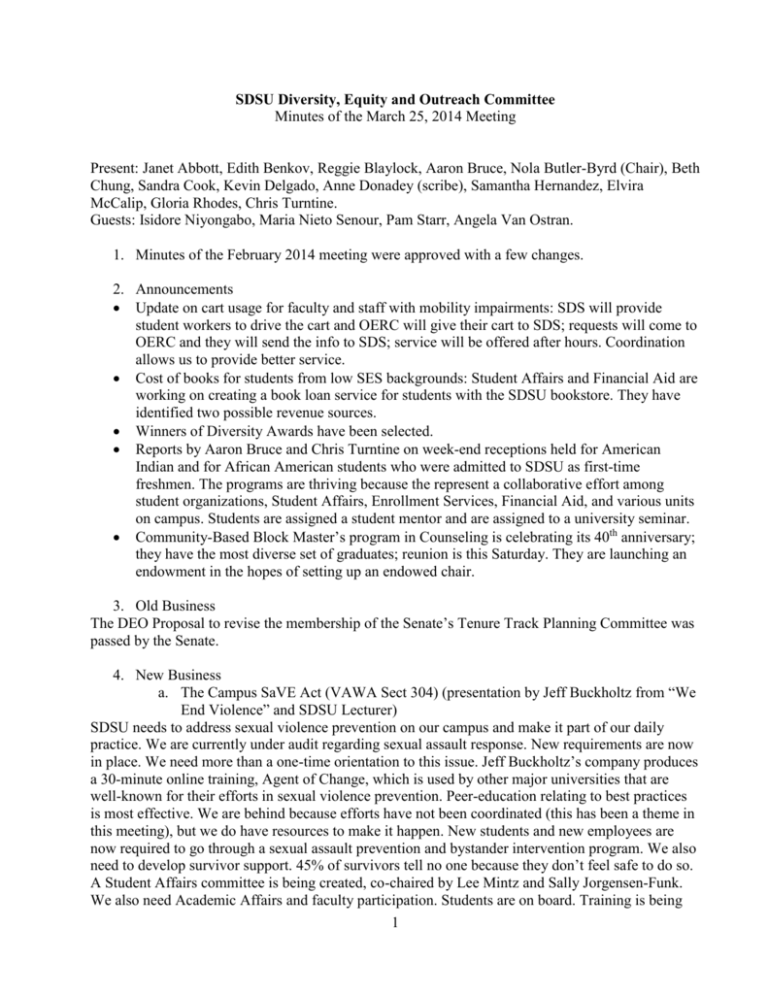
SDSU Diversity, Equity and Outreach Committee
Minutes of the March 25, 2014 Meeting
Present: Janet Abbott, Edith Benkov, Reggie Blaylock, Aaron Bruce, Nola Butler-Byrd (Chair), Beth
Chung, Sandra Cook, Kevin Delgado, Anne Donadey (scribe), Samantha Hernandez, Elvira
McCalip, Gloria Rhodes, Chris Turntine.
Guests: Isidore Niyongabo, Maria Nieto Senour, Pam Starr, Angela Van Ostran.
1. Minutes of the February 2014 meeting were approved with a few changes.
2. Announcements
Update on cart usage for faculty and staff with mobility impairments: SDS will provide
student workers to drive the cart and OERC will give their cart to SDS; requests will come to
OERC and they will send the info to SDS; service will be offered after hours. Coordination
allows us to provide better service.
Cost of books for students from low SES backgrounds: Student Affairs and Financial Aid are
working on creating a book loan service for students with the SDSU bookstore. They have
identified two possible revenue sources.
Winners of Diversity Awards have been selected.
Reports by Aaron Bruce and Chris Turntine on week-end receptions held for American
Indian and for African American students who were admitted to SDSU as first-time
freshmen. The programs are thriving because the represent a collaborative effort among
student organizations, Student Affairs, Enrollment Services, Financial Aid, and various units
on campus. Students are assigned a student mentor and are assigned to a university seminar.
Community-Based Block Master’s program in Counseling is celebrating its 40th anniversary;
they have the most diverse set of graduates; reunion is this Saturday. They are launching an
endowment in the hopes of setting up an endowed chair.
3. Old Business
The DEO Proposal to revise the membership of the Senate’s Tenure Track Planning Committee was
passed by the Senate.
4. New Business
a. The Campus SaVE Act (VAWA Sect 304) (presentation by Jeff Buckholtz from “We
End Violence” and SDSU Lecturer)
SDSU needs to address sexual violence prevention on our campus and make it part of our daily
practice. We are currently under audit regarding sexual assault response. New requirements are now
in place. We need more than a one-time orientation to this issue. Jeff Buckholtz’s company produces
a 30-minute online training, Agent of Change, which is used by other major universities that are
well-known for their efforts in sexual violence prevention. Peer-education relating to best practices
is most effective. We are behind because efforts have not been coordinated (this has been a theme in
this meeting), but we do have resources to make it happen. New students and new employees are
now required to go through a sexual assault prevention and bystander intervention program. We also
need to develop survivor support. 45% of survivors tell no one because they don’t feel safe to do so.
A Student Affairs committee is being created, co-chaired by Lee Mintz and Sally Jorgensen-Funk.
We also need Academic Affairs and faculty participation. Students are on board. Training is being
1
done with fraternities and athletics because they are high-risk populations, but it’s not being done for
other students. They are building something similar to Safe Zones, Safe Spaces for survivors. The
difficulty is that faculty and staff are mandated reporters; the program would be easier to implement
for students. Efforts should be top-down because we have the bottom-up already covered.
Administrators need to make this issue a campus priority. Could the University Senate be involved
to ensure that the academic integrity of the university hinges upon anti-sexual violence and antiracism to ensure student success? The DEO can bring up the issue to SEC and the Senate. We could
have an exit survey of our students to include experiences of discrimination, sexual violence, access
to support services, etc. Stigma is horrible, victim-blaming goes on all the time. We need the
education. One in Four program: we could have one on campus. We need one paid staff to
coordinate all the efforts. Could include assigned time for faculty, GA positions, etc. on the model of
Safe Zones. We could easily move to the next level through coordination. Could have a CTL
workshop on this topic. Also need a survivor-friendly web page for information on the issue.
Samantha will bring it back to AS so student leadership can be involved as well. The issue could be
included more fully in faculty orientation. Online training could be required of faculty.
5. Adjournment

